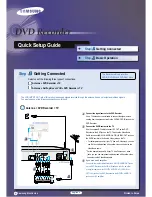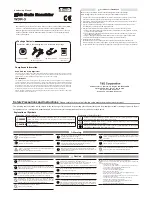
72
RQT8856
Bitstream
This is a signal compressed and converted into digital form. It is
converted back to a multi-channel audio signal, e.g., 5.1-channel, by
a decoder.
CPRM (Content Protection for Recordable Media)
CPRM is technology used to protect broadcasts that are allowed to
be recorded only once. Such broadcasts can be recorded only with
CPRM-compatible recorders and discs.
Decoder
A decoder restores the coded audio signals on DVDs to normal. This
is called decoding.
Dolby Digital
This is a method of coding digital signals developed by Dolby
Laboratories. Apart from stereo (2-channel) audio, these signals can
also be multi-channel audio. A large amount of audio information can
be recorded on one disc using this method.
When recording on this unit Dolby Digital (2 channel) is the default
audio.
Down-mixing
This is the process of remixing the multi-channel audio found on
some discs into two channels. It is useful when you want to listen to
the 5.1-channel audio recorded on DVDs through your TV’s speakers.
Some discs prohibit down-mixing. If this is the case, this unit can only
output the front two channels.
Tracks that do not allow down-mixing will not play correctly on this
unit except when connecting with an HDMI cable to an amplifier that
meets HDMI Ver. 1.1 standards and is CPPM compatible.
DTS (Digital Theater Systems)
This surround system is used in many movie theaters. There is good
separation between the channels, so realistic sound effects are
possible.
Dynamic range
Dynamic range is the difference between the lowest level of sound
that can be heard above the noise of the equipment and the highest
level of sound before distortion occurs. Dynamic range compression
means reducing the gap between the loudest and softest sounds.
This means you can hear dialogue clearly at low volume.
Film and Video
DVD-Videos are recorded using either film or video. The unit can
determine which type has been used, then uses the most suitable
method of progressive output.
Film: Recorded at 25 frames per second (PAL discs) or 24 frames
per second (NTSC discs). (NTSC discs recorded at 30 frames
per second as well.)
Generally appropriate for motion picture films.
Video: Recorded at 25 frames/50 fields per second. (PAL discs)
or 30 frames/60 fields per second (NTSC discs). Generally
appropriate for TV drama programmes or animation.
Finalise
A process that makes play of a recorded CD-R, CD-RW, DVD-R, etc.
possible on equipment that can play such media. You can finalise
DVD-R, DVD-R DL, DVD-RW (DVD-Video format), +R,and +R DL on
the unit. After finalising, the disc becomes play-only and you can no
longer record or edit. However, finalised DVD-RW can be formatted
to become recordable.
Formatting
Formatting is the process of making media such as DVD-RAM
recordable on recording equipment.
You can format DVD-RAM, DVD-RW (only as DVD-Video format) and
+RW on this unit.
Formatting irrevocably erases all contents.
Frame and Field
Frame refers to the single images that constitute the video you see
on your TV. Each frame consists of 2 fields.
=
+
Frame
Field
Field
A frame still shows 2 fields, so there may be some blurring between
them, but picture quality is generally better.
A field still shows less picture information so it may be rougher, but
there is no blurring.
HDMI (High-Definition Multimedia Interface)
HDMI is a next-generation digital interface for consumer electronic
products. Unlike conventional connections, it transmits
uncompressed digital video and audio signals on a single cable. This
unit supports high-definition video output [720p (750p), 1080i (1125i),
and 1080p (1125p)] from HDMI AV OUT terminals. To enjoy high-
definition video a high definition compatible television is required.
JPEG (Joint Photographic Experts Group)
This is a system used for compressing/decoding colour still pictures.
If you select JPEG as the storage system on digital cameras, etc.,
the data will be compressed to 1/10-1/100 of its original size. The
benefit of JPEG is less deterioration in picture quality considering the
degree of compression.
LPCM (Linear PCM)
These are uncompressed digital signals, similar to those found on
CDs. LPCM sound is available when recording in XP mode.
MPEG2 (Moving Picture Experts Group)
A standard for efficiently compressing and expanding colour video.
MPEG2 is a compression standard used for DVD and digital
broadcasting. This unit records programmes using MPEG2.
MP3 (MPEG Audio Layer 3)
An audio compression method that compresses audio to
approximately one-tenth of its size without any significant loss of
audio quality. You can play MP3s you have recorded onto DVD-R,
DVD-R DL, CD-R and CD-RW.
Pan & Scan/Letterbox
In general, DVD-Video are produced with the intention that they will
be viewed on a widescreen TV (16:9 aspect ratio), so images often
don’t fit regular TVs (4:3 aspect ratio). 2 styles of picture, “Pan &
Scan” and “Letterbox”, deal with this problem.
Pan & Scan: The sides are cut off so the picture
fills the screen.
Letterbox:
Black bands appear at the top and
bottom of the picture so the picture
itself appears in an aspect ratio of
16:9.
Playback control (PBC)
If a Video CD has playback control, you can select scenes and
information with menus displayed on the screen.
(The unit is compatible with version 2.0 and 1.1.)
Progressive/Interlace
The PAL video signal standard has 625 (or 576) interlaced (i) scan
lines, whereas progressive scanning, called 625p (or 576p), uses
twice the number of scan lines. For the NTSC standard, these are
called 525i (or 480i) and 525p (or 480p) respectively.
Using progressive output, you can enjoy the high-resolution video
recorded on media such as DVD-Video.
Your television must be compatible to enjoy progressive video.
Panasonic televisions with 625 (576)/50i · 50p, 525 (480)/60i · 60p
input terminals are progressive compatible.
•
•
Glossary
RQT8856-B̲DTP̲070306.indb 72
RQT8856-B̲DTP̲070306.indb 72
2007/04/04 17:49:49
2007/04/04 17:49:49





































